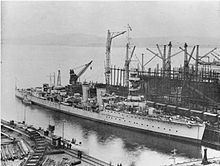Former type Private Defunct 1993 | Founded 1711 Ceased operations 1993 | |
 | ||
Fate Merged into Scott Lithgow (1967) Parent organizations Scott Lithgow, British Shipbuilders, Trafalgar House | ||
Scotts Shipbuilding and Engineering Company Limited, often referred to simply as Scotts, was a Scottish shipbuilding company based in Greenock on the River Clyde. In its time in Greenock, Scotts built over 1,250 ships.
Contents
History
John Scott founded the company, beginning shipbuilding at Greenock in 1711. The Scott family took over the Greenock Foundry in 1790 and C G Scott started building at Cartsdyke Dockyard in 1850 as Scott & Company.
John Scott (II) and Robert Scott bought the adjacent yard of R Steele & Company in 1883 to create the Cartsburn Dockyard, which was laid out for naval shipbuilding. By 1900 John Swire & Company were major shareholders and Henry Scott was a director of Swire Scotts. In 1900–1901 he specified and oversaw construction of Swire's Taikoo Dockyard in Hong Kong. Swire's was 25% owned by the Scott Family.
In 1925 Scott's took over Ross & Marshall's Cartsdyke Mid Yard. In 1934 they exchanged their Cartsdyke East yard for Cartsdyke Mid yard with Greenock Dockyard Ltd. In June 1965 the Company took over Scott's & Sons (Bowling) Ltd and in December 1965 Scott's merged with the Greenock Dockyard Company and the Cartsburn and Cartsdyke Dockyards were fully integrated in 1966.
In 1967 the Company merged with Lithgows to form Scott Lithgow Ltd, operating as Scotts Shipbuilding Co (1969) Ltd. Scott Lithgow Ltd was absorbed into the nationalised British Shipbuilders in 1977.
Cartsdyke Shipyard was closed in 1979 and Cartsburn in 1984. In 1983 the Scott Lithgow company and yards were sold to Trafalgar House.
No further shipbuilding was undertaken and the 270-year-old Scott shipbuilding company finally ceased trading in 1993.
Between 1988 and 1997 the Cartsburn and Cartsdyke shipyards were gradually demolished and redeveloped as insurance offices, computer warehouses and fast food restaurants.
Notable ships
Notable vessels built included the early Royal Mail Steam Packet Company liners Clyde, Dee, Solway and Tweed in 1841, SS Thetis of 1857, which John Scott (1830–1903) financed himself to test his theory about high pressure steam in the compound engine, which worked at about 120 lbf/in2 in Thetis, the early tanker Narragannsett in 1903, the barque Archibald Russell, submarine S1, in 1914, the Cruiser HMS Glasgow in 1937 and the drilling ship Ben Ocean Lancer in 1977. Principal customers of Scotts were Alfred Holt & Co (Blue Funnel Line) (88 ships), The China Navigation Company / John Swire Ltd (95 ships) and the Royal Navy (114 ships). Scotts Assistant Manager James Richardson devised an early "Snorkel" for submarines, for which they were granted British Patent No.106330 of 1917. It was not taken up by the Admiralty for use by the Royal Navy. (See submarine snorkel)
There is extant the builder's certificate of SS Thetis. Captain William Kennedy (1816–1876) of Greenock took Thetis for her trials on the Clyde.
In popular culture
Pictures of some Scotts-built vessels were painted by the Greenock marine artist William Clark. (Glasgow Museum of Transport). A painting of the launch in 1818 from Scotts yard of the wood ship Christian was painted by the Anglo-US marine artist Robert Salmon. (Glasgow Museum of Transport).
Before the Cartsdyke yard closed in the late 1970s it was used to film part of a BBC Television Play for Today called "Just a Boys' Game".
Tercentenary
In 2011, Greenock's McLean Museum and Art Gallery celebrated the tercentenary of Scotts' foundation.
